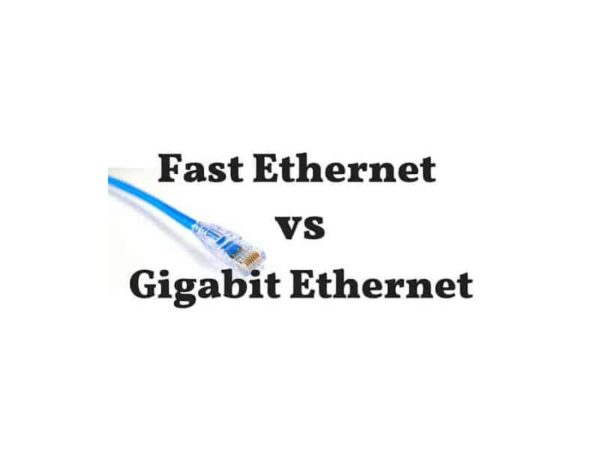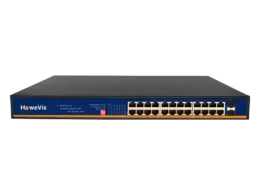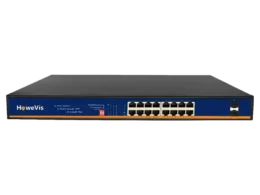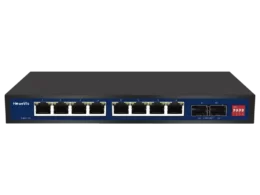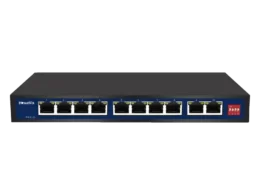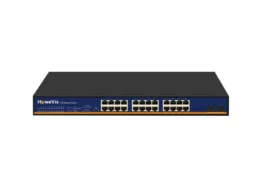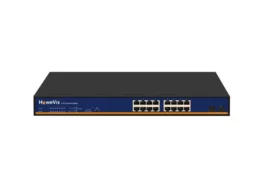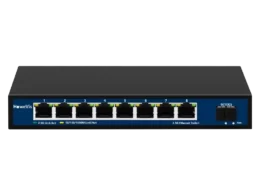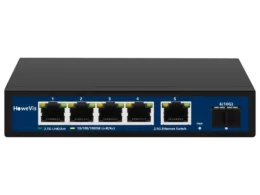Gigabit Ethernet goes a step ahead of Fast Ethernet. But the value it offers in terms of speed is 10x. Gigabit Ethernet enables you to access the speed bandwidth of 1GB per second.
It’s an excellent solution for small and medium enterprises who need fast internet access. The best thing about the network setup is that you don’t need to toy around too much with your existing infrastructure.
Let’s understand the technology and the value it offers. Besides, how the use of PoE switches with Gigabit Ethernet can be a changemaker for your network. So, read on!
How Is Gigabit Ethernet Different From High-Speed Ethernet?
Gigabit Ethernet can transmit data up to 1000 MB per second. And not many devices in conventional office spaces can handle a bandwidth this fast. To realize its full potential, you can divide it into multiple Fast Ethernet connections.
High-speed Ethernet
High-speed Ethernet or fast Ethernet offers a transmission rate of a maximum of 100 MBPS. A bandwidth that is considerably slower to operate in full-scale modern enterprises. But the technology is still relevant. It offers value as a second line of data transmission.
Fast Ethernet effectively runs on network cables. The minimum requirement to run a Fast Ethernet is a Cat5 cable. These network cables have four twisted pairs of wires. However, fast Ethernet uses only two pairs of wires for its data transmission. That’s where the potential lies. It’s the additional pairs of wires that opened the possibilities of Gigabit Ethernet.
Gigabit Ethernet
Gigabit Ethernet works on the same principle as Fast Ethernet does. It makes a difference by using all four pairs of Network cables. IEEE introduced the technology in June 1998. Back in the day, it used the 802.3z standard.
Now it uses IEEE defined 802. ah standard, which is the latest. Gigabit Ethernet runs on both fiber optics and network cables, using fiber optics as an expensive alternative.
At the same time, network cables are not only cheaper but also manageable. They are plug-and-play. The minimum network cable requirement to run a Gigabit Ethernet connection is CAT5e.
What Differences Does Gigabit Ethernet Make?
Let’s have a quick look at how Gigabit Ethernet outperforms conventional High-Speed Ethernet.
RTD
RTD stands for the round trip delay. It’s a parameter to measure the time duration of a browser’s communication to the server. It is the amount of time an internet browser takes to amplify signals to a server. In computer network terminology, the RTD is ping time. Something that you will often see in internet speed tests.
The Gigabit Ethernet has an RTD of about 4000-bit times, while Fast Ethernet has a much longer delay time. RTD for Fast Ethernet is just about 100-bit times.
Coverage
The coverage Standard High-speed Ethernet offer is about 10Kms. At the same time, gigabit ethernet is well ahead at this front. It gives a good range of about 50-70 Kms.
Now you are aware of the distinctions between Fast-Ethernet and Gigabit Ethernet. It more or less answers the question of how Gigabit Ethernet can make a difference to your network.
So, we can move on to what it takes to set up Gigabit infrastructure.
Which Cables Work Best on Gigabit Port?
Now, you might be wondering – Does Gigabit Ethernet require a special cable? Gigabit Ethernet works on the same Ethernet Cables, but not all cables support 1GB/second data transmission. The standard Category 5 cable used for Fast Ethernet will not work with Gigabit. Anything above Cat5e is good.
To run Gigabit Ethernet efficiently, you can choose from the following three options.
Cat 5 e
The category five enhanced cables are good enough to handle Gigabit Ethernet. Also, they are considerably cheaper than the other two options. They do a good job of reducing crosstalk. You don’t need to worry about unwarranted signal transfers.
Cat 5 e is the best option if you are looking for an affordable option. You can get 12 feet of cable in less than 9 USD.
Cat 6
Category 6 cables support the same transmission speed as Cat5e. But they almost double the bandwidth compared to Cat5e network cables. Higher bandwidth means you will need less time for uploading and downloading files from the server.
Suppose your enterprise requires transmission of large files within the Local Area Network. The Cat 6 cable justifies the investment. Category 6 cables also come with shielding.
Shielding is nothing but another protective layer around the network cable. With this shield, you can almost deny any potential network interference from outside.
However, not all Category 6 cables are shielded. If you are looking for a shielded cable, make sure you confirm with the seller. The wires must have a “shielded twisted pair.” Some manufacturers brand it as “STP-enabled cables.” So, look for it.
Cat 6a
Category 6 a is an advanced network cable. The “a” in Cat 6 means “augmented.” The cable offers a data transmission rate of up to 10,000 MB per second. It is the speed which is straightway ten times faster than what Cat5e cables provide. Also, all Category 6a cables come with augmented shielding.
The cables are a good investment if you have immediate business scalability plans in place. They offer not only security but also reliability.
However, there are more advanced cables like Cat7 and Cat7a are also available. They are very expensive. And you might not need anything beyond Cat 6a even if you upgrade your network speed to 10,000 MBPS.
Compatibility of Gigabit Ethernet With PoE
Gigabit Ethernet can work efficiently with PoE as well. When you use POE with fast Ethernet, it uses two unused pairs of wires to transmit power. But the question begs here, how it is possible with Gigabit Ethernet, which uses all four pairs of network cable? That’s when PoE switches come into play.
PoE switches can easily control power operation on your Gigabit Ethernet. The regulators make sure that only PoE-enabled devices get a power supply. If the device is not PoE enabled, it will only transmit data to that line.
Also, modern managed switches give a lot of control over your network. With the help of these switches, you can change the security configuration of your network. Manage your network remotely etc.
How Does PoE Use Cat5e/Cat6 Cables?
Irrespective of the network cable you are using, Cat 5e, Cat 6, or any other advanced cable, PoE’s principle remains the same. We all are aware electric current runs in a loop. It needs two conductors to transmit power to a network cable. So, what PoE does, is it takes one pair of network cables and uses it as a single conductor. And repeats the process with other couples making electric flow possible.
The voltage that PoE injects over network cables ranges between 44-75 volts DC. But it uses only 48 volts DC for operation. The extra voltage makes sure the power supply remains constant.
The voltage that PoE uses is relatively safe. But if a particular device is not PoE enabled, it can harm it. That’s why it’s essential to use PoE switches. If budget is a limiting factor, you can go with unmanaged switches. The unmanaged switches do not provide advanced features like security configurations. But they are good enough to manage power operations.
Besides, here we have listed the top 8 issues you should know about PoE switch cabling.
Final Thoughts!
Gigabit Ethernet is possibly the most efficient low-cost boost that you can give to your business. Irrespective of the domain you operate in, a quality network is as crucial as cash flow for companies nowadays.
With a better network and connectivity, you can unlock the potential of your business. The more you go digital, the more it becomes easier to run a business. And bring efficiency and accountability to the system. It also helps increase employee engagement and recruitment. The benefits are enormous compared to the investment you make in advanced Ethernet cables and PoE switches.
